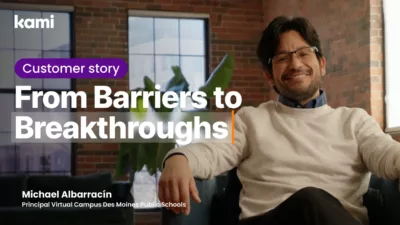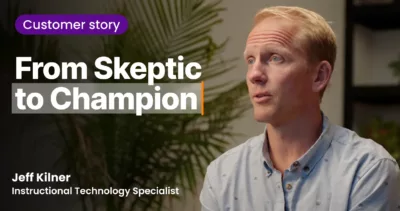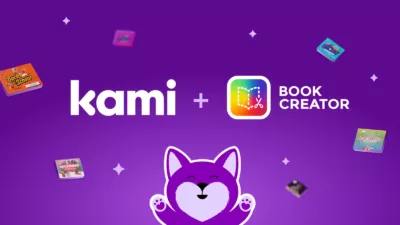For veteran educator Laurel Aguilar-Kirchhoff, the path to edtech innovation began with a chance encounter. “I first came across Kami at a Q conference. Their booth caught my attention, it was fun and sparkly, with live demos on big screens. This was pre-pandemic, so I saw it as an annotation tool but didn’t explore its potential much further at the time.”
What started as a simple tool soon revealed itself to be much more. “Later, as I transitioned to teaching at the university level, I wasn’t actively using Kami but often recommended it for K-12 classrooms. Then, last year, Steve (Steve Martinez-Escalon, Kami Teacher Success Champion) and I were talking about issues like academic dishonesty and plagiarism in my classes, particularly with the rise of AI. I was frustrated and looking for solutions. Steve reminded me, ‘You have the solution—you have Kami.’”
A conversation that shifted Laurel’s perspective. “I realized my understanding of Kami was outdated. It wasn’t just an edtech tool anymore—it had evolved into a comprehensive learning platform.”
This rediscovery marked a turning point in Laurel’s teaching journey, opening her eyes to Kami’s extensive capabilities beyond simple annotation.
Transforming the Classroom Experience
Kami proved to be particularly valuable for Laurel in addressing modern teaching challenges. “When ChatGPT launched, I explored it with my students in real time. For context, my students are in California’s teacher credentialing program, which requires graduate-level work. These students are either pursuing their credentials or teaching as interns. Soon after using ChatGPT, I noticed their reflections became very AI-like, certain words like ‘delve’ and ‘foster’ kept popping up. I started creating a list of these patterns and realized I wasn’t reading my students’ authentic thoughts. It was a wake-up call for me to redesign my courses.”
Her solution was comprehensive: “I flipped my classroom and began using Kami to make learning more interactive. I’d screenshot key text sections, run text recognition to make them interactive and embed questions and videos. Students would come to class prepared to engage with the material in Kami. It streamlined my grading process too, as everything integrated seamlessly with Canvas. Now, I even have my students creating their own Kami documents for collaborative projects and gallery walks. Everything we do models how they can use these tools in their future classrooms.”
This transformation not only addressed the immediate challenges of AI-generated content but also created a more engaging and authentic learning environment that prepared future teachers for the modern classroom.
Supporting Diverse Learning Needs
Kami’s versatility proved particularly valuable for addressing various learning needs. “For literacy, I focus on showing teachers how to use Kami’s accessibility and scaffolding features to make rigorous content accessible to all students. Kami supports all four domains of language—reading, writing, speaking, and listening, within one platform. For example, students can record themselves, listen to teacher recordings, and type or annotate directly on documents.”
These comprehensive features ensure that every student, regardless of their learning style or needs, can fully participate in and benefit from the learning experience.
Preparing Future Educators
In her university teaching role, Kirchhoff implements a structured approach to technology integration. “At first, I used a gradual release model. I created all the assignments in Kami, moved the text, added videos, and shared it with them. They worked within Kami and turned it in. As the semester went on, I released more responsibility to them. Now, they’re creating in Kami themselves. All of our group discussions and final project visuals are done in Kami. They know the features now and how to create with them both as students and as teachers.”
This methodical approach ensures that future educators not only master the tool themselves but gain practical experience in implementing technology effectively in their own teaching practice.
The Impact on Teaching and Learning
For Kirchhoff, the app’s value extends beyond basic functionality. “Having access to Kami gives students opportunities to engage in learning meaningfully. For example, the dictionary feature breaks down barriers for students who need extra support. It’s about universal design for learning—reducing barriers wherever possible. Some think edtech takes teachers out of the equation, but I think Kami increases teacher-student interaction. It takes tasks off teachers’ plates, giving them more time for personalized learning.”
Her enthusiasm for Kami is clear: “I’d miss everything. Don’t even joke about Kami going away, that would be the worst. I love having everything in one platform. It’s amazing to have all the tools I need in one place. If I accidentally log into the free version, I’m like, ‘Nope, I need the full version with all the bells and whistles.’ Kami is my one-stop shop.”
For Laurel, Kami has become more than just an educational tool—it’s an essential partner in creating an inclusive, interactive, and effective learning environment that meets the demands of modern education.
This story is part of our ongoing series exploring educator’s stories around digital learning. Stay connected for more inspiring stories about reshaping education with technology.
Discover more
Explore more customer stories to see how Kami is transforming classrooms worldwide. To learn how Kami can support your classroom, school, or district, speak to our team today.
Blogs you may also like

Virtual Campus School: Turning Learning Barriers into Breakthroughs with Kami

How Jeff Kilner and His District Transformed Teaching with Kami



